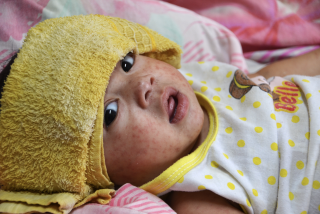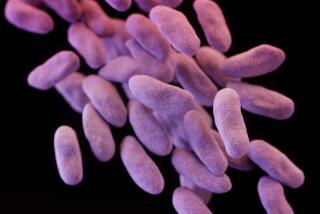Scientists warn a germ-phobic nation against going too far
- Share via
Antibacterial soaps, disinfectants and dust-free environments may be doing as much harm as good, we’re now learning. But for a nation that thinks the only good germ is a dead germ, going cold turkey on the microbe-killers is unlikely.
So scientists are trying to compensate for our obsession with cleanliness, even as they attempt to better understand how our allergy and asthma-wracked bodies may be the casualties of overkill.
Some researchers are trying to kick-start our immune systems by exposing them to microbes they wouldn’t otherwise encounter. Others are trying to help people who already suffer from allergy, asthma or autoimmune diseases.
“We are at a point where we know our original ideas -- that germs were bad and dogs were bad for allergies -- were oversimplified and not correct,” said Dr. Marshall Plaut of the National Institute of Allergy and Infection Diseases. But, he said, “we don’t know the right balance between bacterial exposure being harmful and bacterial exposure being beneficial.”
What they suspect is that, by purging our environment of many germs and microbes, we’ve deprived our immune systems of the chance to recognize them as a natural part of the environment. When we do encounter such substances, in the form of bacteria, viruses, fungi, along with pet dander, dust, pollen and similar irritants, our bodies overreact. We wheeze and sneeze.
Asthma rates have soared in the last 20 years. Not only has the lung disorder become one of the most common diseases of childhood, it’s become increasingly fatal. At the same time, autoimmune illnesses such as Type 1 diabetes, multiple sclerosis and Crohn’s disease (a painful inflammation of the intestines) are all on the rise.
Louise Varbanov, mother of a healthy 3-year-old, has been paying close attention to the recent reports on germs and illness. The Cresskill, N.J., resident has taken a page from her Bulgarian-born husband, who was raised with a more casual attitude about dirt and germs.
“I keep my house clean, but I don’t keep it germ-free, and I purposely don’t use antibacterial cleansers,” she said. “I think it will not allow him to develop immunity to things that we’re exposed to in the everyday world.”
In fighting mode by age 3
For thousands of years, men and women lived in a fairly contaminated environment, surrounded by a sea of bacteria and other microbes. Our bodies learned to sense their presence and respond appropriately. This ability, scientists have shown, becomes rooted in the first six to 24 months of life. By age 3, our bodies have learned all they need to know to unleash fighting cells against invaders.
But by insulating ourselves so well and interfering with early exposures that should set the body’s sensors correctly, we’ve disturbed the system. Work from a growing number of research teams is reinforcing the hygiene hypothesis, which holds that exposure to microbes and getting infected with some of them strengthens the body’s natural immune system against allergies. Without it, they contend, we’re more liable to see the part of our immune system responsible for wheezing, inflammation and other allergic symptoms run wild.
The theory has recently been expanded to incorporate autoimmune diseases too, in which the immune system goes into overdrive and begins attacking itself.
Most recently, European researchers, reporting in the Sept. 19 New England Journal of Medicine, showed that German, Swiss and Austrian children living on farms and exposed naturally to bacteria from animals had just half the allergies and less asthma than children of similar socioeconomic backgrounds living in villages.
Before that, U.S. researchers had shown in several studies that kids who are exposed to other children’s colds and infections in day-care have less asthma and fewer allergies later in life. Other studies have shown that kids who have a cat or dog from a very young age have less asthma and fewer allergies than those who have grown up without pets.
However, Dr. Juan Celedon, a researcher into the genetics and epidemiology of asthma at the Channing Laboratory at Brigham and Women’s Hospital in Boston, says this doesn’t apply if your mother has asthma.
He recently co-authored a study in the medical journal Lancet showing that exposure to high levels of cat allergen protected against wheezing in the first five years of life only in those children whose mothers did not have asthma. Exposing kids with asthmatic moms to high levels of cat allergen “was associated with higher levels of wheezing in ages 3 to 5.”
He predicted that within 10 years, “we’re going to be able to identify things that are going to be protective and make some recommendations.”
Using power of microbes
Dr. Fernando D. Martinez of the University of Arizona’s Respiratory Sciences Center, is among those looking to harness the power of microbes for the prevention of allergy, asthma and autoimmune disorders. Instead of constantly trying to battle the things that make us scratch, sneeze or cough, he wants to find approaches that would let us live more harmoniously with the plethora of microbes and animals around us.
Of course, exposing a child to the bacteria that protected farm kids in Europe is a tricky proposition because it could make them sick.
Instead, Martinez says: “What I want to find is a product that imitates exposure without having to go to the farms.”
While he’s focused on prevention, others, like Dr. Eyal Raz, a researcher at UC San Diego, are trying to find ways to help asthma and allergy sufferers. Raz is using synthetic DNA that can provoke or stimulate the immune system the way bacterial DNA does, but without making the patient sicker.
In essence, he said, “we tried to domesticate the dirt, to purify the dirt.” So far, his work is being done in animals, where Raz said it has succeeded in inhibiting diseases such as Crohn’s.
But all the strides taking place in the laboratory don’t mean we shouldn’t wash our hands before we eat or that we should bring the livestock indoors. Nor does it diminish the power of clean water, sterile operating rooms and vaccination against childhood diseases to help most of us, unlike our ancestors, survive well beyond our first birthdays. Martinez tells parents to get a pet if they’d like, unless their child already is allergic. If they want to place their children in day-care early on, he advises them not to feel guilty about it, unless the child has so many recurrent infections that the pediatrician says it’s unhealthy. And if a child drops some food on the floor, it’s probably just fine to pick it up, wipe it off and eat it because “children are perfectly capable of eating non-sterilized food.”
“Don’t pay too much attention to the excessive protection we have set as a rule,” said Martinez, noting that kids living in Eastern Europe, where the rules are much more lax, have few allergies and little asthma.
Varbanov, the New Jersey mom, even takes a laissez faire approach to the colds and viruses her son picks up in day-care and preschool. “You’re kind of toughening them up, so when they get into grade school, they’re less likely to take sick and fall behind.”






